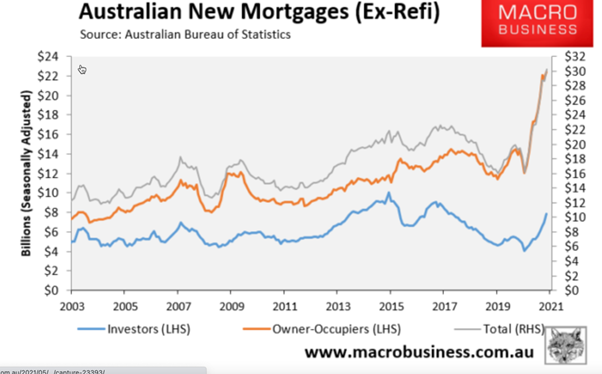‘Never before have such fortunes been made overnight by so many people,’ said American journalist and statesman Edwin LeFevre in his narrative of the ‘Roaring 1920s’.
It was the ‘get-rich-quick’ era.
Many were still suffering from the previous depression in 1920.
But regardless, the notion was that anyone could become a millionaire overnight from speculation on Wall Street.
‘Only the hardiest spoilsports rose to protest that the wild and unchecked speculative fever might be bad for the country…
‘The money lay in stacks in Wall Street, waiting to be picked up. You had to be an awful deadhead not to go get some.’
Historian Paul Sann, The Lawless Decade
The Roaring Twenties led us to the peak of the post-war real estate cycle in 1929.
‘In January of 1929…there was no one to look over the edge of the cliff and note how far it was down to the bottom of the canyon.’
Stewart Holbrook, The Age of the Moguls
The ‘bottom of the canyon’ was the worst economic downturn in the history of the industrialised world.
It lasted from 1929–39.
By 1933, 15 million Americans were unemployed and nearly half the country’s banks had failed.
Importantly, however, are the remarkable similarities to the current real estate cycle and what can be termed, the Roaring 2020s.
I mentioned it first to readers in April 2020’s edition of Cycles, Trends & Forecasts.
The point at which the COVID-panic had destroyed markets globally.
The media touted that we’d be in a recession at least as bad as the Great Depression.
However, the similarities to the 1918–20 Spanish flu and what became known as ‘The Lost Depression’ between 1920 and 1921 were far greater.
The Spanish flu produced lockdowns on the same scale as we experienced in 2020.
Governments were quick to take advantage with a tyrannical power grab that no one would have imagined months before.
This depression was worse in many respects than the Great Depression.
Notably:
- The real estate market did not crash. It continued to rise throughout — just as it has throughout the COVID mid-cycle panic.
- It was followed by one of the most robust recoveries of any recession between 1899 and the Great Depression.
- A ‘V’-shape recovery — just as we’re experiencing today.
Notable was the technological revolution that followed.
It was this that fuelled the Roaring Twenties.
- Televisions were invented.
- Homes were connected to the electrical grid and indoor plumbing.
- The first cross-Atlantic flight was successfully navigated.
- Cars and electrical manufacturing took hold.
- Jukeboxes were invented.
The transformation led to a sharp rise in productivity.
- It forever changed the size and living arrangements of households and workplaces.
- Women achieved a new level of independence. Awareness of ‘women’s issues’ started to change society in ways that benefited women.
- There was huge expansion in credit and construction.
All societal changes that bear similarities to what we see happening today.
I said to subscribers of Cycles, Trends & Forecasts back in April last year:
‘And with technology being the only option to connect with people in the current pandemic, it won’t be surprising to see a similar trend following in 2021.’
It’s important to note, however, that whilst the mainstream labelled the Roaring Twenties as merely a stock market bubble…
It was in fact the formation of a monumental land bubble — that contributed to the massive banking failures.
Land is where the money on Wall Street was ultimately settling.
In the US, it was termed ‘The Florida Land Boom’ — however, it extended across much of the nation.
Between 1921 and 1929, lending on real estate in the US increased by 179%, and urban prices more than doubled.
The wealth that flowed to landowners, was immense.
Thousands of new banks set themselves up in outlying areas.
There was an explosion in the value of construction that would not be equalled until the boom-and-bust era of the late 1980s.
Scoot forward to recent times, and I’ve been saying since the beginning of COVID that Australia is entering its biggest ever real estate boom — based on the repeating pattern of economic cycles.
That couldn’t come without riding on the back of its biggest ever mortgage boom.
After all, real estate is basically worth what the banks are willing to lend.
And here we are…
|
|
| Source: MacroBusiness |
It’s mostly been driven by owner-occupiers.
But investors are now getting into the game.
So much so that Australia’s banks are calling for ‘compassion’ from mortgage brokers as they struggle to process the massive influx of applications:
‘Loan approval times at large lenders have blown out to a month or more as some work through a deluge of borrowers seeking to refinance at record low rates and first-home buyers scrambling to get into the property market…
‘Bankers accepted their systems and processes had not held up under a 50 per cent increase in applications through the broker or third-party channels, with many speaking of the additional resources they had put on to clear the bottlenecks…
‘Commonwealth Bank general manager Adam Croucher said… “Our application volumes almost doubled in the second half of 2020, something we could not have anticipated to happen during a once-in-100-year pandemic”…’
Melbourne’s median house has just hit a record $1 million.
Sydney’s median house prices exceed $1.3 million.
It’s enough to put fear in the mind of any investor, thinking we may be nearing another peak.
But just like the Roaring Twenties, we have some years to go yet.
Money will continue to pump into the real estate market — especially in the smaller capitals — Perth, Brisbane, etc.
You don’t need to take out a massive mortgage, however.
There are many ways you can advantage from the boom as a small-cap investor, so long as you’re comfortable with highly volatile stocks — all of which we reveal over at Cycles, Trends & Forecasts.
Best wishes,
 |
Catherine Cashmore,
For The Daily Reckoning Australia
PS: Our publication The Daily Reckoning is a fantastic place to start your investment journey. We talk about the big trends driving the most innovative stocks on the ASX. Learn all about it here.


